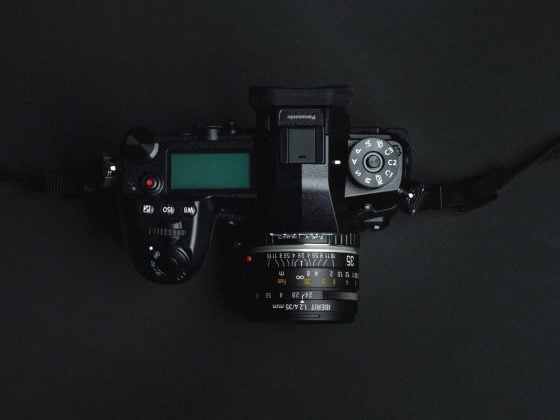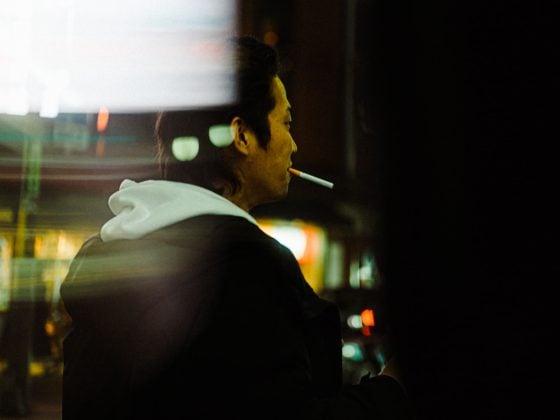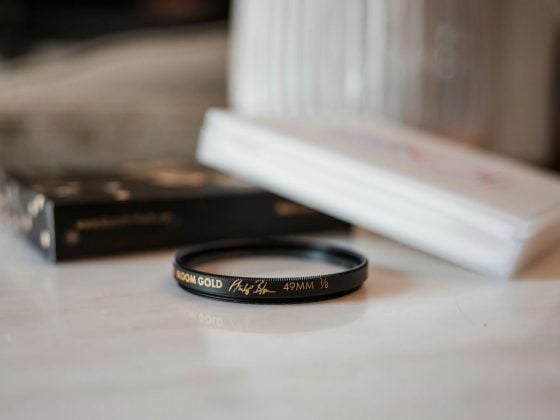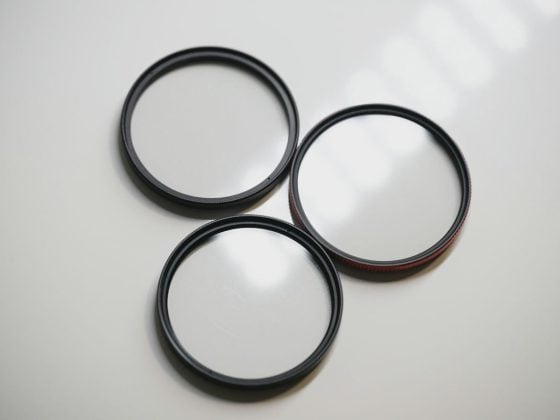The new Tamron’s 15-35mm f2.8 Ultra-Wide Zoom lens has now shipped and I’ve been lucky enough to get my hands on one. This is the latest and greatest from Tamron and is designed to feed the hungry 50 megapixels on the new Canon 5Ds and other high-megapixel cameras. To see how true this claim is, I’ve spent the last few days testing this lens with both the Canon 5Dmkii and the Sony A7r with the metabones MKIII adapter.
This will be a living, breathing review since it takes me a long time to really put a lens through its paces. I should have a lot of great information regarding user experience in the next few weeks, but in the meantime, here is my detailed review.
Tamron SP – 15-30mm f2.8 First Impressions

This is the first Tamron lens I’ve owned, and it’s impressive and very solid.
If you want to order the lens, check out these links.
Tamron 15-35mm f2.8 – Amazon
Usability
I’ve used the Tamron 15-30 on the Canon 5Dmkii and the Sony A7r. It feels made for DSLRs and doesn’t feel quite right on the Sony A7r. Plus, it has many issues with my Metabones III adapter. I’m hoping the Metabones MKIV adapter will perform a lot better.
With the Canon, there is enough body weight and size to counter the weight of this lens, and it feels really good holding and shooting it, except it’s heavy. On the Sony A7r, I feel you have to favor holding the lens instead of using the camera grip; it’s too heavy for a small camera like this.
Canon 5Dmkii
On the Canon, autofocus is snappy, and the image stabilizer works great. Everything just works perfectly with the Canon version. No complaints about my 5Dmkii.

With the Vibration Compensation on, I successfully shot sharp images handheld with a 1/20 shutter without motion blur.
Sony A7r – Metabones MKIII Adapter
My Sony A7r has some issues. I’m still using the Metabones EF to E Mount Adapter MkIII, which could contribute to the problems.
First, it doesn’t accurately focus at all. So, autofocus is not an option.
Second, even if it was focusing, it liked to go into continuous focus mode automatically. Maybe the Metabones IV adapter will work better, or maybe ordering the lens in an A-mount and using the Sony adapter will work great. But I don’t know. My Metabones adapter does do strange things with other lenses, but nothing like this.
Third, Multimetering does some strange things. Everything seems to work normally at lower f-stops around f5.6 and lower. At higher f-stops, around f/11 or higher, I need to set my exposure compensation dial to around -2 to expose accurately. Switching to center metering or spot metering fixes this.
As mentioned earlier, it feels too big for the Sony A7r, it’s uncomfortable to carry and the lens weight to camera balance is awkward. It makes me want to switch back to my DSLR when using a lens like this, but I’ll manage. I know this isn’t the lens’s fault; bigger lenses are usually better at IQ, and that’s what Tamron was going for.
I wouldn’t recommend this lens if you’re shooting an E-mount camera and only have the Metabones III adapter.

Single Exposure, Sony A7r @ 15mm, ISO 100, f/16, 1/3sec
Built Quality

The build quality is excellent. Made of hard plastic, it feels very solid, with no rattling. The focus ring and zoom ring all feel very tight. I would think it was a Canon L lens if I didn’t know. It feels like one, actually better.
Watch out for the lens slides within the barrel when zooming. This is a lens design I’m always afraid of. From my experience, designs like this tend to cause the lens to suck in more dust since zooming in and out creates a vacuum. This happened on my Canon 16-35mm f2.8L II when shooting in the dusty desert.
Size and Weight

It’s heavy and it’s big, how a good ultra-wide lens should be, but something to keep in mind if you do a lot of hiking and traveling.
It feels better than the Canon 16-35mm f2.8L II. Bigger and heavier, it feels all around more durable.
Tech Specs

Image stabilization and autofocus are bonuses. But I never use either on an ultra-wide lens since they are usually used for landscapes or architecture, where the live view is typically used to perfect the focus. I’m sure some people will love it, and I’m glad it’s there.
Lens Features
Improved Lens Coating – The BBAR (Broad-Band Anti-Reflective) has been refined and improved, and the band has been added to reduce ghosting and flaring, resulting in a crystal-clear, crisp image. And I can say this works well. I have a hard time creating flares when pointing into the sun.
Coating – Front element coating that is designed to keep the lens smudge and dust-resistant. And when the lens is dirty, it should be easier to clean. B+W uses a similar technology on their UV filters, which I really like, and you do notice it.
Nine Blade Aperture – allows for a really smooth Bokeh with a maximum aperture of f2.8.
Autofocus uses an Ultrasonic Silent Drive – Helps reduce the chatter of a lenses autofocus. This lens still produces some autofocus chatter but it’s not too bad.
VC or Vibration Compensation – Optical image stabilizer that should help you shoot handheld in darker situations. For example if you’re a travel photographer and you’re in one of those locations where you can’t use a tripod, like the Grand Central Station in New York, this could be handy.
Resolving Power
Diffraction Limit
This will depend on what camera you use. On the Sony A7r, the diffraction starts to be noticeable between f8 and f11.
F11 is still pretty good, and F16 is stilln’t terrible. Honestly, I was expecting a lot worse.
f4 – f8 seems to be the sweet spot.
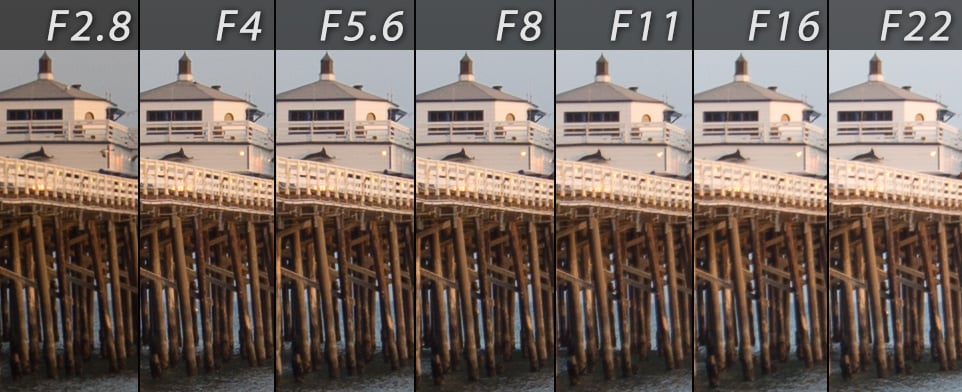
Chromatic Aberrations
Chromatic Aberrations seem to be very well controlled. It’s probably my best-performing lens regarding CA, which is a Zoom.
This is a chromatic aberration sample taken from the very far left of the frame with a 100% crop.

Detail With The Sony A7r With Metabones
I first tested this lens with the Sony A7r to see how it performs with higher megapixels. But it’s not designed for this camera, and it shows.
Image samples @15mm, ISO 100, f/8, 1/30 sec.
You can also see barrel distortion here, which isn’t that bad.
You can click this image to view its original size on Smugmug and scroll around to see the image yourself. I’ve also posted 100% crop samples.

Center Detail
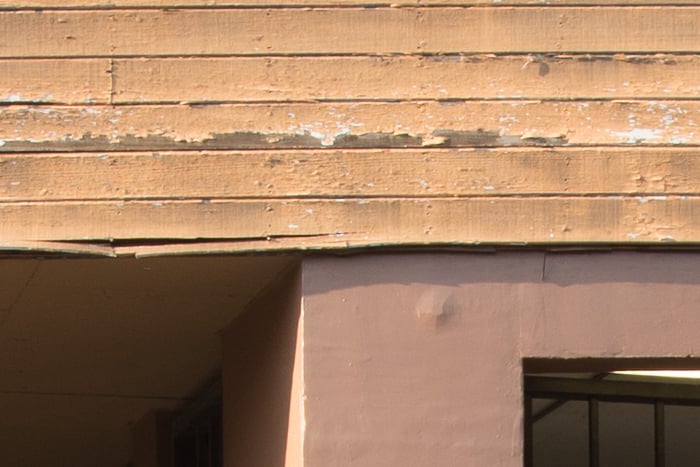
Top Right Corner Detail
I noticed it is pretty soft. But I think that’s because it’s adapted to work with the Sony A7r. Further down, I’ll post a few images taken with the 5Dmkii as well.
I’ve noticed that the edge and corner detail are a lot nicer on the Canon.
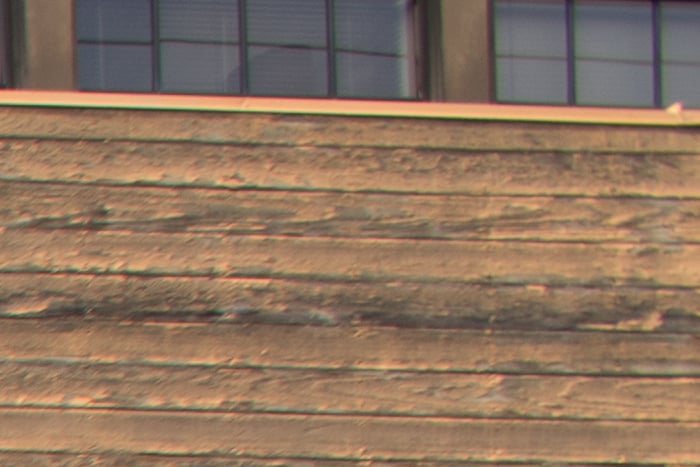
Right Edge Detail
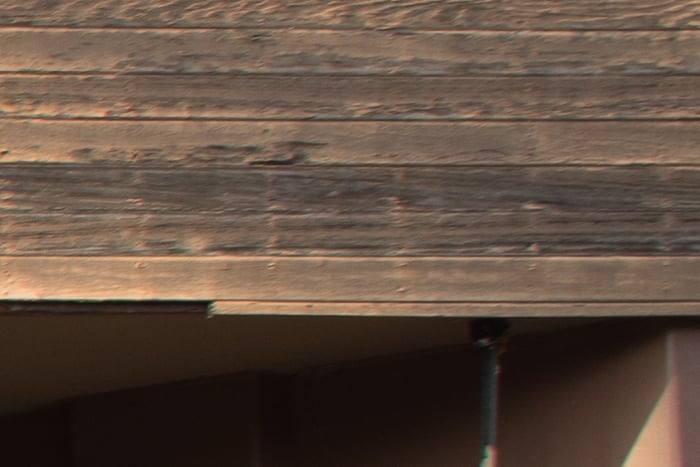
Sample @30mm
ISO 100, f/8, 1/30 sec.

Detail On Canon 5Dmkii
The lens performs much better on the 5Dmkii than on the Sony A7r. The edges and corners look much nicer.
Image samples @15mm, ISO 100, f/8, 1/20 sec
You can click this image and view the original size on smugmug and scroll around to see the image yourself. I’ve also posted 100% crop samples.

Center Detail
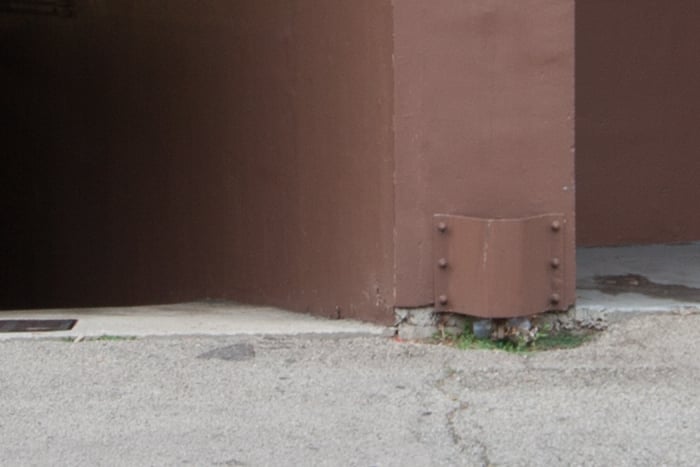
Top Right Corner Detail
Much nicer detail and color compared to the Sony A7r.
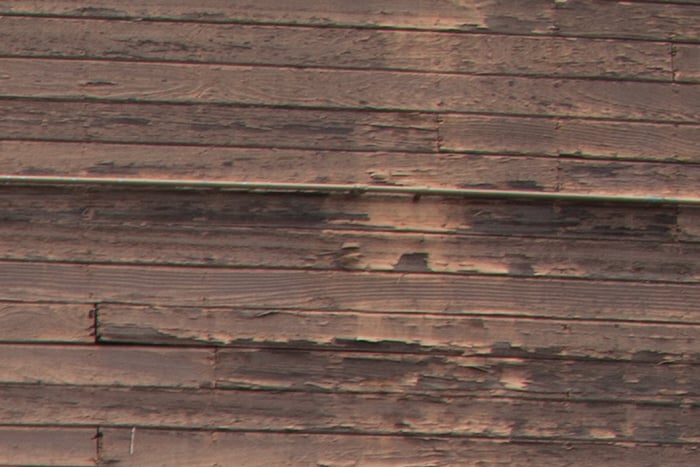
Right Edge Detail
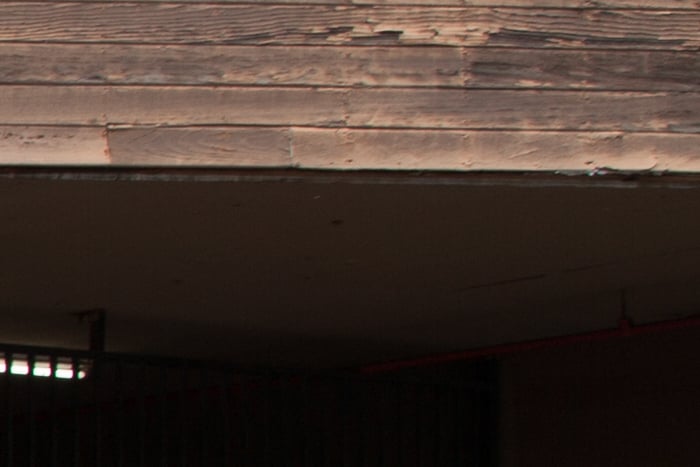
Top Right Edge With 0.4 High Pass Overlay Sharpness Added
A little bit of sharpening goes a long way to clean up those corners.
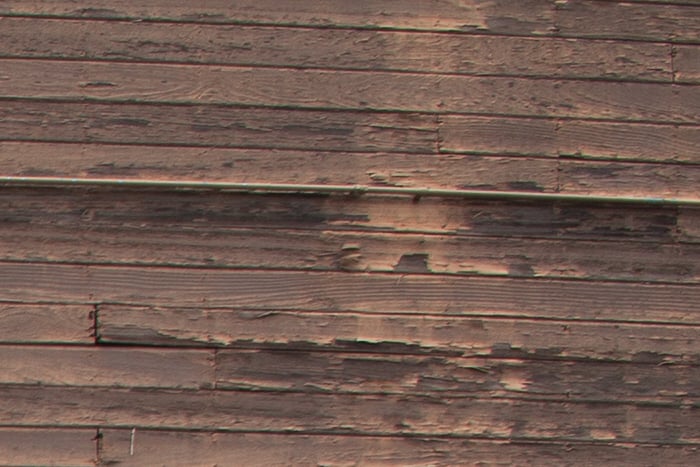
Sample @24mm
The lens seems sharper at 24mm and 30mm, and any softness in the corners is removed.
ISO 100, f8, 1/10sec

Sample @30mm
ISO 100, f8, 1/8sec

Here is a shot with the Canon 5Dmkii; no sharpness or noise reduction is added.

Canon 5Dmkii, ISO 100, f2.8, 2sec

Canon 5Dmkii, ISO 100, f16, 15sec
If you scale in to 100%, you’ll notice a lot nicer corner and edge detail. I’ll post better samples with the 5Dmkii soon.
Vignetting

Vignetting seems to be the biggest problem, but it’s also easy to correct. I hope we see a Lightroom profile for this lens soon.
Tamron 15-30mm vs Canon 16-35mm f2.8L II
When Tamron announced the development of the 15-30mm lens, they said it would be designed for 50-megapixel cameras.
I can’t test the lens with a 50MP camera because I don’t have one yet, but I can test it on the Sony A7r which is 36 megapixels, close enough.
The more megapixels a sensor has, the smaller the pixels. Small pixels mean lower quality at higher apertures due to diffraction. So to test how this lens handled diffraction compared to my Canon 16-35mm f2.8L II, I ran a diffraction test with both lenses to see the difference.
Tamron @15mm vs Canon @16mm 100% crop
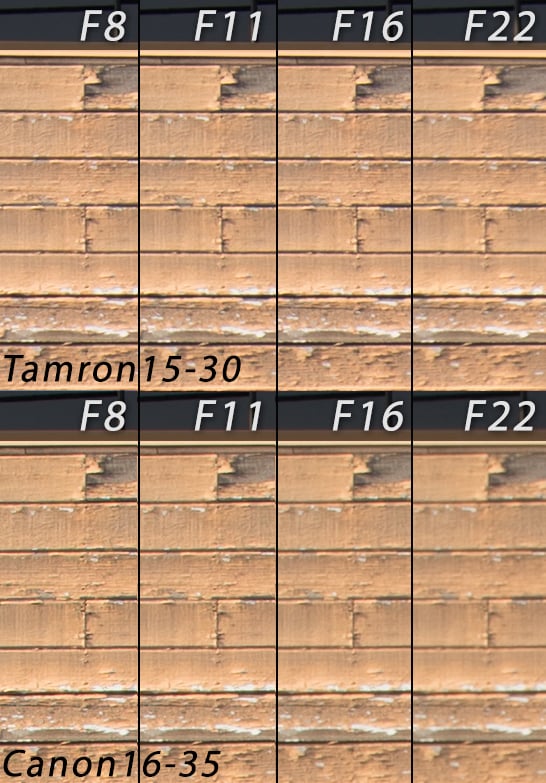
I noticed the Tamron’s image quality was far less influenced by diffraction than the Canon.
Tamron 15-30 f2.8 Review Conclusion
On The Canon
This lens is amazing. It’s rock solid, built well, and vibration compensation and autofocus work great on my Canon, no major flaws, but it is heavy. It’s not crazy sharp @15mm like some other ultra-wide zooms, but it does clean up as you start zooming in.
On The Sony
It looks like it doesn’t play nice with the Sony A7r. This could be because that camera uses a different microlens configuration on its sensor, which isn’t fully designed to work with lenses with the rear mount in the DLSR position.
On the Canon, this thing looks great. It seems much sharper than the Sony A7r, and you have to consider that the Canon 5Dmkii is old and has an optical low-pass filter, so by default, it should be significantly softer than the Sony A7r. On the Canon 5Ds or a Nikon D810, I imagine this lens will be amazing and clean up well with just a little bit of sharpness.
Does it compete with the Nikkor 14-24mm? I’m not sure. It’s hard to tell until I can get them side-by-side, but from what I’ve seen of the Nikkor, it looks close. It’s a small upgrade from the Canon 16-35 f2.8L II, but unlike the Canon, it maintains quality at high apertures, which is very important for landscape shooters and future high-megapixel cameras.
Pros
Very minimum flaring
Low distortion
Excellent quality at high apertures.
Lens stabilization
Good Chromatic Aberration Control
Fast aperture (f2.8) Great for Astrophotography
Excellent color rendition
Cons
Big & Heavy
Only moisture-resistant, not fully weather-sealed
Smeary corners compared to some competition
Not as sharp as the competition in the center
No filter threads
Doesn’t play nice with Sony E-mount cameras.
If you don’t have an ultra-wide zoom lens, this is a good deal if you don’t mind owning a big, heavy lens. But if you already have a good ultra-wide zoom lens like the Canon 16-35 f2.8L II, 16-35mm f4, the Sony Zeiss 16-35, or the Nikkor 14-24, then this lens might only be a minor upgrade, and only in some areas like high aperture detail and chromatic aberration control.
Tamron SP 15-30mm f2.8 Sample Images
I’ll have more sample images soon, but here is what I’ve shot in the last few days. I’ll also try to shoot more on the Canon since the quality is much improved.
When you click the image, you’ll see an option at the bottom right that allows you to view the original size.

Single Exposure – Sony A7r @ 15mm, ISO 100, f/16, 1/3sec

Single Exposure, Sony A7r @ 15mm, ISO 100, f8, 1/15sec

| **This website contains affiliate links. We will earn a small commission on purchases made through these links. Some of the links used in these articles will direct you to Amazon. As an Amazon Associate, I earn from qualifying purchases. |


